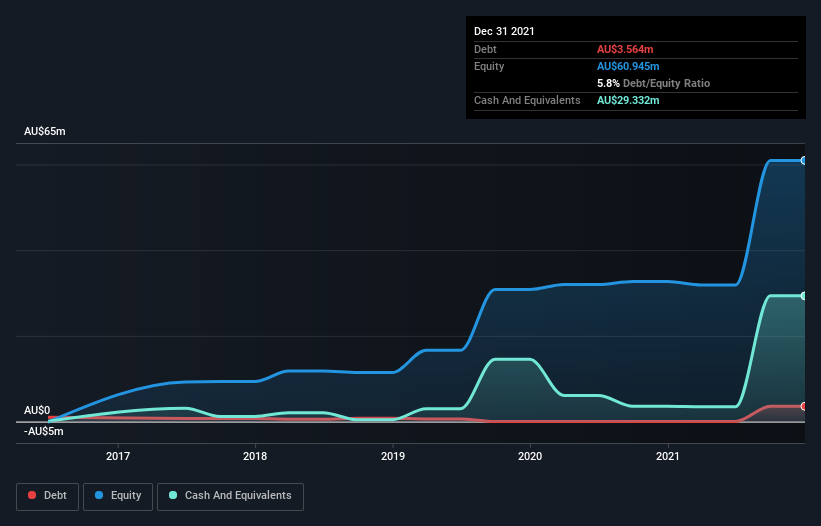Murray Cod Australia (ASX:MCA) May Not Be Profitable But It Seems To Be Managing Its Debt Just Fine, Anyway
Warren Buffett famously said, 'Volatility is far from synonymous with risk.' When we think about how risky a company is, we always like to look at its use of debt, since debt overload can lead to ruin. We can see that Murray Cod Australia Limited (ASX:MCA) does use debt in its business. But the real question is whether this debt is making the company risky.
When Is Debt A Problem?
Generally speaking, debt only becomes a real problem when a company can't easily pay it off, either by raising capital or with its own cash flow. Part and parcel of capitalism is the process of 'creative destruction' where failed businesses are mercilessly liquidated by their bankers. While that is not too common, we often do see indebted companies permanently diluting shareholders because lenders force them to raise capital at a distressed price. Having said that, the most common situation is where a company manages its debt reasonably well - and to its own advantage. When we think about a company's use of debt, we first look at cash and debt together.
Check out our latest analysis for Murray Cod Australia
What Is Murray Cod Australia's Debt?
You can click the graphic below for the historical numbers, but it shows that as of December 2021 Murray Cod Australia had AU$3.56m of debt, an increase on AU$19.3k, over one year. But it also has AU$29.3m in cash to offset that, meaning it has AU$25.8m net cash.

A Look At Murray Cod Australia's Liabilities
Zooming in on the latest balance sheet data, we can see that Murray Cod Australia had liabilities of AU$3.71m due within 12 months and liabilities of AU$10.9m due beyond that. On the other hand, it had cash of AU$29.3m and AU$1.30m worth of receivables due within a year. So it actually has AU$16.0m more liquid assets than total liabilities.
This surplus suggests that Murray Cod Australia has a conservative balance sheet, and could probably eliminate its debt without much difficulty. Succinctly put, Murray Cod Australia boasts net cash, so it's fair to say it does not have a heavy debt load! The balance sheet is clearly the area to focus on when you are analysing debt. But ultimately the future profitability of the business will decide if Murray Cod Australia can strengthen its balance sheet over time. So if you're focused on the future you can check out this free report showing analyst profit forecasts.
Over 12 months, Murray Cod Australia reported revenue of AU$10m, which is a gain of 66%, although it did not report any earnings before interest and tax. With any luck the company will be able to grow its way to profitability.
So How Risky Is Murray Cod Australia?
Statistically speaking companies that lose money are riskier than those that make money. And we do note that Murray Cod Australia had an earnings before interest and tax (EBIT) loss, over the last year. Indeed, in that time it burnt through AU$10m of cash and made a loss of AU$4.7m. But the saving grace is the AU$25.8m on the balance sheet. That means it could keep spending at its current rate for more than two years. Murray Cod Australia's revenue growth shone bright over the last year, so it may well be in a position to turn a profit in due course. Pre-profit companies are often risky, but they can also offer great rewards. There's no doubt that we learn most about debt from the balance sheet. However, not all investment risk resides within the balance sheet - far from it. Case in point: We've spotted 2 warning signs for Murray Cod Australia you should be aware of.
When all is said and done, sometimes its easier to focus on companies that don't even need debt. Readers can access a list of growth stocks with zero net debt 100% free, right now.
New: Manage All Your Stock Portfolios in One Place
We've created the ultimate portfolio companion for stock investors, and it's free.
• Connect an unlimited number of Portfolios and see your total in one currency
• Be alerted to new Warning Signs or Risks via email or mobile
• Track the Fair Value of your stocks
Have feedback on this article? Concerned about the content? Get in touch with us directly. Alternatively, email editorial-team (at) simplywallst.com.
This article by Simply Wall St is general in nature. We provide commentary based on historical data and analyst forecasts only using an unbiased methodology and our articles are not intended to be financial advice. It does not constitute a recommendation to buy or sell any stock, and does not take account of your objectives, or your financial situation. We aim to bring you long-term focused analysis driven by fundamental data. Note that our analysis may not factor in the latest price-sensitive company announcements or qualitative material. Simply Wall St has no position in any stocks mentioned.
About ASX:MCA
Murray Cod Australia
Murray Cod Australia Limited, together with its subsidiaries, breeds, grows, and markets freshwater and table fish in Australia.
Adequate balance sheet with low risk.
Similar Companies
Market Insights
Community Narratives


Recently Updated Narratives

Proximus: The State-Backed Backup Plan with 7% Gross Yield and 15% Currency Upside.

CEO: We are winners in the long term in the AI world

Early mover in a fast growing industry. Likely to experience share price volatility as they scale
Popular Narratives


MicroVision will explode future revenue by 380.37% with a vision towards success


The company that turned a verb into a global necessity and basically runs the modern internet, digital ads, smartphones, maps, and AI.



